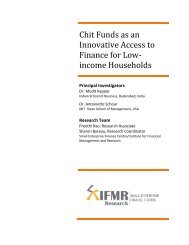Government of India Volume I: Analysis and Recommendations
Government of India Volume I: Analysis and Recommendations
Government of India Volume I: Analysis and Recommendations
Create successful ePaper yourself
Turn your PDF publications into a flip-book with our unique Google optimized e-Paper software.
ANNEXES<br />
31. The WG recommends the move towards the FHC model as with appropriate accounting<br />
<strong>and</strong> reporting st<strong>and</strong>ards, it will help in identification <strong>of</strong> systemic risk buildup<br />
in large financial conglomerates.<br />
With appropriate accounting <strong>and</strong> reporting st<strong>and</strong>ards the move towards the FHC<br />
model will help in identification <strong>of</strong> systemic risk buildup in large financial conglomerates.<br />
32. There are concerns which arise with insolvency proceedings <strong>of</strong> entities which are<br />
systemically important. In this regard the WG endorses the recommendation <strong>of</strong> CFSA<br />
to keep resolution <strong>of</strong> these entities separate from those relating to ordinary companies.<br />
33. This WG endorses the recommendations <strong>of</strong> CFSA which recognises the need for a<br />
regulatory agency which would conduct periodic assessments <strong>of</strong> macro-economic<br />
risks <strong>and</strong> risk concentrations. This agency must also monitor functioning <strong>of</strong> large,<br />
systemically important, financial conglomerates anticipating potential risks.<br />
34. While research <strong>and</strong> academic literature in systemic risk is relatively new, based on<br />
the existing experience <strong>of</strong> the countries <strong>and</strong> as endorsed by its inclusion in the Basel<br />
III report, the WG recognises the need for countercyclical capital buffer as a policy<br />
tool for dealing with systemic risk.<br />
35. In our view, the threshold limits for application <strong>of</strong> Recovery <strong>of</strong> The Recovery <strong>of</strong><br />
Debts Due to Banks <strong>and</strong> Financial Institutions Act, 1993 (RDDBFI) must not be stated<br />
in the act. The Central <strong>Government</strong> must have the power to determine the limit<br />
through rules. In addition, the capability <strong>and</strong> efficiency <strong>of</strong> Debt Recovery Tribunals<br />
(DRTs) must be measured on an ongoing basis <strong>and</strong> limitations must be addressed<br />
efficiently. The threshold limit after which cases may be filed before the DRT may<br />
be decreased only if the efficiency <strong>and</strong> capability permit.<br />
36. This WG endorses the recommendations <strong>of</strong> Malegam Report on Urban Co-operative<br />
Banks (2011) <strong>and</strong> recommends a separation <strong>of</strong> the ownership <strong>of</strong> UCBs. In this way<br />
the banking business would be separated from the co-operative society. This would<br />
ensure that the regulatory treatment <strong>of</strong> the banking arm <strong>of</strong> the co-operative society<br />
is at par with banks. With the implementation <strong>of</strong> this recommendation the banking<br />
arm <strong>of</strong> co-operative banks must also be granted the same privileges available<br />
to banks under the Securitisation <strong>and</strong> Reconstruction <strong>of</strong> Financial Assets <strong>and</strong> Enforcement<br />
<strong>of</strong> Security Interest Act, 2002 (SARFAESI) <strong>and</strong> RDDBFI.<br />
37. Section 14 <strong>of</strong> SARFAESI is silent on the time period within which petitions are required<br />
to be disposed <strong>of</strong>f by the Chief Metropolitan Magistrate or District Magistrates.<br />
Since no time lines are prescribed, these petitions take longer than required<br />
to be disposed <strong>of</strong>f leading to unnecessary delays. In International Asset Reconstruction<br />
Company Private Limited through its Authorised Representative <strong>of</strong> Constituted<br />
Attorney Mr. Tushar B. Patel v. Union <strong>of</strong> <strong>India</strong>, through the District Magistrate <strong>and</strong> Others<br />
noting the significant delay caused in enforcing security interests under Section<br />
14 <strong>of</strong> SARFAESI petitions, the Bombay High Court has prescribed a time line <strong>of</strong> two<br />
months for all petitions filed under Section 14 <strong>of</strong> SARFAESI. This WG recommends<br />
that the law should prescribe a time period (perhaps 2 months) within which the<br />
District Magistrate or the Chief Metropolitan Magistrate, as the case may be, should<br />
dispose <strong>of</strong>f Section 14 petitions. Those who fail to meet the time limit should be<br />
required to report the number <strong>of</strong> cases where they took longer than the prescribed<br />
time limit.<br />
38. Neither Section 14 <strong>of</strong> SARFAESI nor the rules prescribed under SARFAESI, state what<br />
documents are required for filing a petition for enforcing a security. This leads to<br />
uncertainty in procedure with different courts requiring different documents leading<br />
to unnecessary delays. The Debt Laws Amendment Bill (2011), addresses this<br />
FINANCIAL SECTOR LEGISLATIVE REFORMS COMMISSION 187



